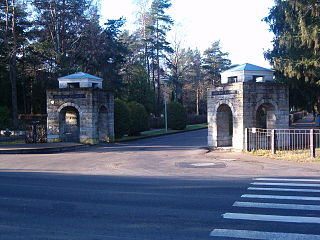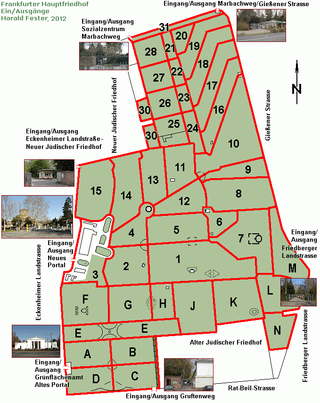Overview
It lies on the border to the Ostermundigen municipality, has been opened in 1877 as a replacement for the rose garden and then extended several times. It has rare wild plants, many species of birds, bats and small animals. A nature trail provides information on over 200 trees and shrubs.
The Schosshaldenfriedhof contains the family grave of Paul Klee, with a bronze plaque and the following quote:
- I cannot be grasped in the here and now. For I reside just as much with the dead as with the unborn. Somewhat closer to the heart of creation than usual. But not nearly close enough. [1]
The Schosshaldenfriedhof appears in Friedrich Dürrenmatt′s The Judge and His Hangman as the burial place of the murdered fictional character Police Lieutenant ″Ulrich Smith″ (or ″Dr. Prantl″).
The Cemetery of Montmartre is a cemetery in the 18th arrondissement of Paris, France, that dates to the early 19th century. Officially known as the Cimetière du Nord, it is the third largest necropolis in Paris, after the Père Lachaise Cemetery and the Montparnasse Cemetery.

Paul Klee was a Swiss-born German artist. His highly individual style was influenced by movements in art that included expressionism, cubism, and surrealism. Klee was a natural draftsman who experimented with and eventually deeply explored color theory, writing about it extensively; his lectures Writings on Form and Design Theory, published in English as the Paul Klee Notebooks, are held to be as important for modern art as Leonardo da Vinci's A Treatise on Painting was for the Renaissance. He and his colleague, Russian painter Wassily Kandinsky, both taught at the Bauhaus school of art, design and architecture in Germany. His works reflect his dry humor and his sometimes childlike perspective, his personal moods and beliefs, and his musicality.

The Vienna Central Cemetery is one of the largest cemeteries in the world by number of interred, and is the most well-known cemetery among Vienna's nearly 50 cemeteries. The cemetery's name is descriptive of its significance as Vienna's biggest cemetery, not of its geographic location, as it is not in the city center of the Austrian capital, but on the southern outskirts, in the outer city district of Simmering.

The Hagenbund or Künstlerbund Hagen was a group of Austrian artists that formed in 1899. The group's name derived from the name Herr Hagen, the proprietor of an inn in Vienna which they frequented.

The Lenbachhaus is a building housing an art museum in Munich's Kunstareal.

Rahumäe cemetery is a cemetery located at Rahumäe in Nõmme District, Tallinn, Estonia. This municipal cemetery was established in 1903 on 29 hectares of land to meet the needs of the growing population of Tallinn. A number of congregations are present including a Jewish section established in 1911. This forested cemetery is notable for its many works by famous sculptures and chapels present within its grounds.

The Friedhof Heerstraße cemetery is located at Trakehnerallee 1, district of Charlottenburg-Wilmersdorf in Berlin, Germany, to the east of the Olympiastadion. It covers an area of 149,650 square meters.

The Waldfriedhof Dahlem is a cemetery in Berlin, in the district of Steglitz-Zehlendorf on the edge of the Grunewald forest at Hüttenweg 47. Densely planted with conifers and designed between 1931 and 1933 after the plans of Albert Brodersen, it is one of Berlin's more recent cemeteries. Its graves include those of writers such as Gottfried Benn, composers such as Wolfgang Werner Eisbrenner and entertainers like Harald Juhnke, and put it among the so-called "Prominentenfriedhöfe" or celebrity cemeteries.

The Gottbegnadeten-Liste was a 36-page list of artists considered crucial to Nazi culture. The list was assembled in September 1944 by Joseph Goebbels, the head of the Ministry of Public Enlightenment and Propaganda, and Germany's supreme leader Adolf Hitler.

The Alter Südfriedhof also known as "Alter Südlicher Friedhof" is a cemetery in Munich, Germany. It was founded by Duke Albrecht V as a plague cemetery in 1563 about half a kilometer south of the Sendlinger Gate between Thalkirchner and Pestalozzistraße.

Powązki Military Cemetery is an old military cemetery located in the Żoliborz district, western part of Warsaw, Poland. The cemetery is often confused with the older Powązki Cemetery, known colloquially as "Old Powązki". The Old Powązki cemetery is located to the south-east of the military cemetery.
Baumann is a German surname, and may refer to:

Melaten is the central cemetery of Cologne, North Rhine-Westphalia, which was first mentioned in 1243. It was developed to a large park, holding the graves of notable residents.

Waldfriedhof Zehlendorf is a cemetery located in Berlin's Nikolassee district. The cemetery occupies an area of 376,975 m2. An additional Italian war cemetery was created there in 1953. A number of notable people of Berlin are buried at the cemetery; some have a grave of honor. In particular, all of Berlin's deceased post-war mayors are buried here.

The Hauptfriedhof in Karlsruhe is one of the oldest German communal rural cemeteries. In 1871, the first plans to build a new burial ground outside the city center began. The cemetery was laid out in 1874 by Josef Durm in the Rintheim district, east of the actual city, after the inner-city Alter Friedhof Karlsruhe in the Oststadt had become too small. The main cemetery has grown from its original size of 15.3 hectares in 1873 to over 34 hectares. The graves of more than 32,000 deceased are currently in the cemetery.
This page is based on this
Wikipedia article Text is available under the
CC BY-SA 4.0 license; additional terms may apply.
Images, videos and audio are available under their respective licenses.















